Power Pitch
Preclinical Brain & Beyond
ISMRM & ISMRT Annual Meeting & Exhibition • 10-15 May 2025 • Honolulu, Hawai'i

| 08:15 |
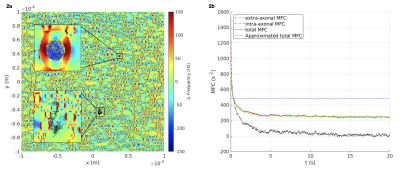 |
Screen Number: 1
0820. Magnetic
Field Correlation Imaging Quantifies Demyelination and Axonal
Loss
L. Kitchingman, A. Hertanu, M. Jallais, K. Şimşek, O.
Girard, G. Duhamel, L. Soustelle, R. Turner, E. Kopanoglu,
I. Jelescu, M. Palombo
Cardiff University, Cardiff, United Kingdom
Impact: Magnetic Field Correlation imaging provides
quantitative information on changes to myelin status
complementary to other MRI techniques, and offers new ways
to characterise microstructural changes in neurodegenerative
diseases.
|
| 08:17 |
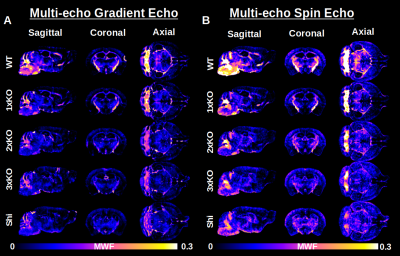 |
Screen Number: 2
0821. Quantitative
comparison of multi-echo spin echo and multi-echo gradient echo
myelin water imaging in a panel of Mbp-enhancer edited mouse
strains
V. Grouza, Y. Shi, S. Goldfarb, K. Bednarz, M. Tuznik, H.
Bagheri, A. Peterson, T. Stroh, D. Rudko
Montreal Neurological Institute and Hospital, Montreal, Canada
Impact: This study establishes mGRE-based MWF as a
reliable alternative to MESE, offering shorter scan times
and improved resolution for myelin imaging in preclinical
models. It advances the potential of myelin water imaging in
translational research and future clinical applications.
|
| 08:19 |
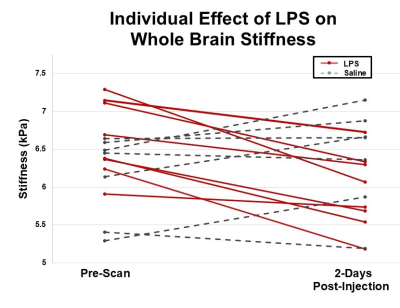 |
Screen Number: 3
0822. Magnetic
Resonance Elastography Detects Whole Brain Stiffness Reductions
during Acute Bacterial-Induced Neuroinflammation
S. Vander Wiele, L. Williams, K. Milbocker, E. Zarate, A.
Klintsova, C. Johnson
University of Delaware, Newark, United States
Impact: This study is the first to quantify the brain
mechanical response due to bacterial infection-induced acute
neuroinflammation. These results may be useful in
understanding the connection between acute neuroinflammatory
events and the onset of neurodegenerative disease.
|
| 08:21 |
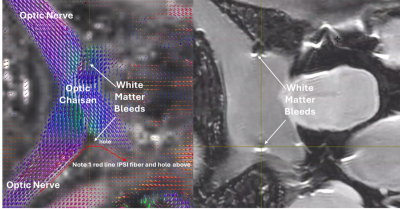 |
Screen Number: 4
0823. Detection
of Diffuse White Matter Damage in a Sheep Model of Blast-Induced
Traumatic Brain Injury Using SS3T diffusion MRI
S. Pathak, D. Cortes, R. Mejia-Alvarez, J. Manfredi, Y. Wu,
W. Schneider
University of Pittsburgh, PITTSBURGH, United States
Impact: This work enhances the detection of diffuse
white matter damage following bTBI by utilizing advanced
diffusionMRI techniques, enabling earlier and more precise
identification of injuries that conventional imaging might
miss, thus improving the potential for effective
interventions.
|
| 08:23 |
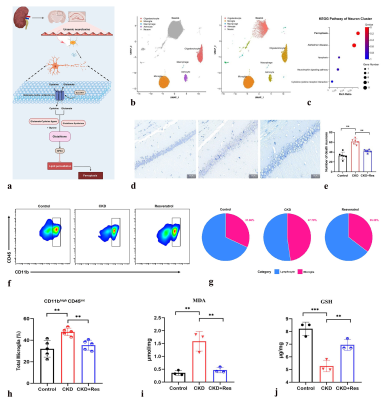 |
Screen Number: 5
0824. Assessment
of white matter disconnection and Ferroptosis in chronic kidney
disease mouse
Z. Yu, Z. Lin, D. Wu
Zhejiang University, Hangzhou, China
Impact: CKD-associated cognitive impairment is
predominantly caused by the ferroptosis-induced
dysconnectivity and destruction of the rich-club subnetwork,
especially in the hippocampus. The
ferroptosis-inhibitor-resveratrol may serve as the
therapeutic method for improving cognitive function in CKD
patients.
|
| 08:25 |
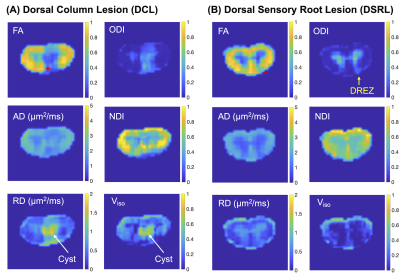 |
Screen Number: 6
0825. Diffusion
MRI Reveals Distinct Abnormalities in the Spinal Cord Following
Unilateral Dorsal Column Lesion and Sensory Nerve Root Injury
F. Wang, L. M. Chen, J. Gore
Vanderbilt University Medical Center, Nashville, United States
Impact: Neurite orientation dispersion and density
imaging (NODDI) offers specific and sensitive metrics to
assess early spinal cord structural changes post-injury.
NODDI detects cysts after dorsal column lesion and subtle
alterations in the dorsal root entry zone after sensory root
injury.
|
| 08:27 |
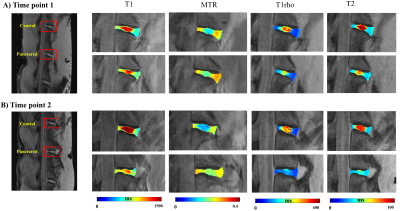 |
Screen Number: 7
0826. Quantitative
UTE Imaging of the Intervertebral Disc in a Rabbit Spine Disc
Puncture Model
J. Athertya, A. Suprana, J. Lo, S. Jerban, K. Red, Y. Ge, M.
Brown, K. Masuda, Y. Ma
Department of Radiology, UCSD, San Diego, United States
Impact: The proposed quantitative UTE imaging techniques
enable comprehensive assessment of the IVD degeneration and
may improve understanding of the mechanism of low back
pain.
|
| 08:29 |
 |
Screen Number: 8
0827. Resting-state
functional connectivity in mouse cervical spinal cord at 15.2T
T-W Lee, F. Wang, A. Sengupta, A. Mishra, L. M. Chen, J.
Gore
Vanderbilt University, Nashville, United States
Impact: This work shows the potential to detect BOLD
signals in mouse spinal cords and derive network
characteristics in mouse models of different disorders.
|
| 08:31 |
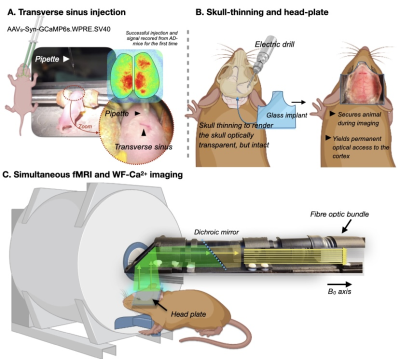 |
Screen Number: 9
0828. Simultaneous
WF-Ca2+ and BOLD-fMRI reveals modality-specific and sex-based
differences in prodromal Alzheimer’s disease
F. Mandino, X. Shen, C. Fredericks, S. Strittmatter, E. Lake
Yale School of Medicine, New Haven, United States
Impact: Relative to men, women face twice the lifetime
risk of AD-related cognitive impairment. Causes of this
discrepancy are unknown and understudied–especially in
animal models. We report a novel dual-imaging framework for
studying sex- and AD-related network disruption in mice.
|
| 08:33 |
 |
Screen Number: 10
0829. Tissue-susceptibility
matched electrodes for simultaneous magnetic resonance imaging
A. von Raven
Max Planck Institute for biological cybernetics, Tuebingen, Germany
Impact: The presented electrode is an alternative to
conventional electrodes, especially at ultrahigh field
strengths. Since it was possible to perform simultaneous
echo-planar imaging and voltage recording, those electrodes
could be used for animal experiments to gain improved
functional information.
|
| 08:35 |
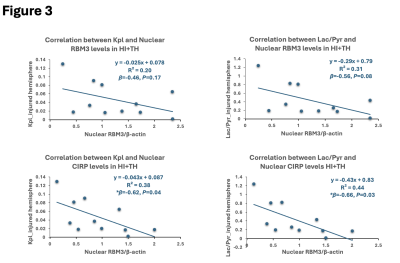 |
Screen Number: 11
0830. Brain
metabolism profile predicts the upregulation of cold-stress
proteins after hypothermia in murine hypoxia-ischemia
X. Liu, A. Capper, N. Stewart, X. Jiang, W. Byrne, X. Ji, J.
Ellison, D. Xu, D. Ferriero
UCSF, San Francisco, United States
Impact: The cold stress protein, i.e., CIRP levels could
be used as one of the hypothermia-regulated targets to
promote the TH effect on those who are not responsive to the
hypothermia.
|
| 08:37 |
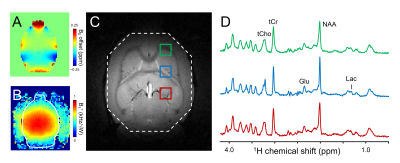 |
Screen Number: 12
0831. 1H-[13C]
MR spectroscopic imaging of dynamic glucose metabolism in rat
brain in vivo
R. de Graaf, M. Thomas, H. De Feyter
Yale University, New Haven, United States
Impact: 1H-[13C]-MRSI
is characterized by unique spectral features not offered by
other dynamic metabolic imaging methods (HP, DMI). The
ability to separate cerebral Glu from Gln and detect total
and 13C-labeled
pools makes 1H-[13C]-MRSI
an unique and valuable metabolic imaging method.
|
| 08:39 |
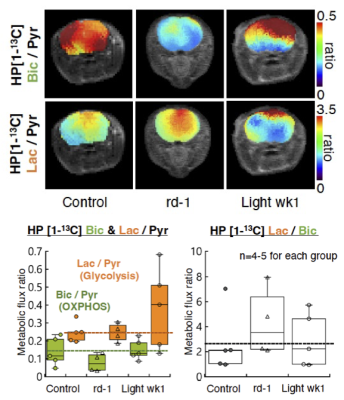 |
Screen Number: 13
0832. Brain
metabolic alterations in murine models of retinal degeneration
using parahydrogen-polarized [1-13C]pyruvate MRI.
S. Matsumoto, S. Suto, H. Hirata
Hokkaido University, Sapporo, Japan
Impact: Hyperpolarized [1-13C]pyruvate
MRI revealed metabolic alterations in the brain of murine
models with retinal degradation, reflecting serotoninergic
activity and behavioral abnormalities often undetected by
anatomical 1H
MRI in the absence of overt neurodegeneration.
|
| 08:41 |
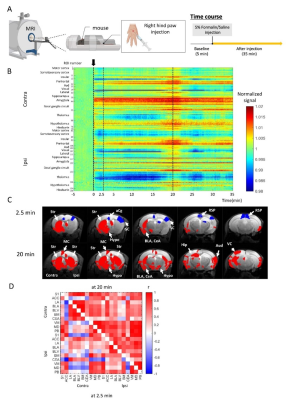 |
Screen Number: 14
0833. Application
of zero-echo time imaging for whole brain activity mapping
without signal loss in mice.
A. Imamura, R. Araki, Y. Takahashi, K. Miyatake, F. Kato, S.
Honjoh, T. Tsurugizawa
Ph. D. Program in Humanics, University of Tsukuba, Tsukuba, Japan
Impact: This study demonstrates ZTE fMRI’s capacity to
image activation in the amygdala, even during pain
responses, enabling previously challenging investigations
into nociception-related networks. This breakthrough opens
new avenues for studying pain pathways and emotion
regulation, with potential translational relevance.
|
| 08:43 |
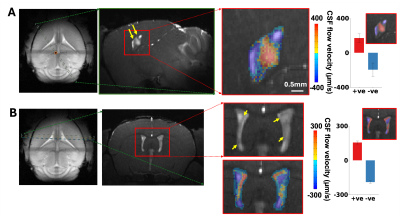 |
Screen Number: 15
0834. Resolve
3D choroid plexus structure and partitioned bidirectional
cerebrospinal fluid flow with MRI
X. Zhou, X. Liu, D. Glen, X. Yu
Athinoula A. Martinos Center for Biomedical Imaging, Boston, United States
Impact: Our findings clarify choroid plexus morphology
and its crucial role in regulating bidirectional CSF flow
dynamics. This study reveals novel CSF hydrodynamics
controlled by ChP localization, informing therapeutic
strategies to target ChP function in degenerative or
hydrocephalic conditions.
|
| 08:45 |
 |
Screen Number: 16
0835. Structural
MRI Analysis of Pregnancy-Related Brain Region Volumetric
Changes in Mice: A Step Toward a Translational Animal Model
A. Korotcov, M. Kutschman, T. Adebayo, S. Purnomuo, S.
Anisowicz, M. Hood, T. J. Wu
Uniformed Services University of the Health Sciences, Bethesda, United States
Impact: This study an attempt to establish a
foundational mouse model to explore pregnancy-related brain
reorganization based on volumetric changes across brain
regions. Further exploration could advance understanding of
maternal brain plasticity and inform research on cognitive
and emotional health postpartum.
|
| 08:47 |
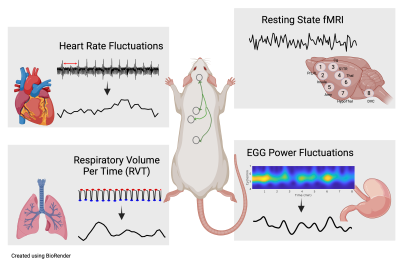 |
Screen Number: 17
0836. Resting
State Interoception Network Integrates Multi-Organ
Representations Via Peripheral Neural Pathways
F. Alkaabi, X. Wang, M. Choi, Z. Liu
University of Michigan, Ann Arbor, United States
Impact: We report that the resting brain actively
processes interoceptive signals and forms overlapping
representations of the heart, lungs, and gut through
peripheral neural pathways. Our findings challenge the
notion that bodily physiological fluctuations are vascular
artifacts to fMRI.
|
| 08:49 |
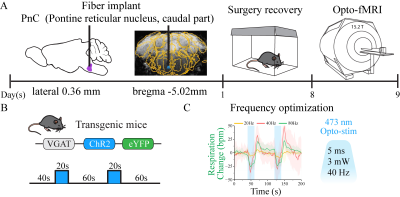 |
Screen Number: 18
0837. Optogenetic
fMRI of Pontine Reticular Nucleus for Mapping Respiratory
Networks
T. Jin, G. H. Im, S-H Choi, T. Vo, S. Han, S-G Kim
Center for Neuroscience Imaging Research (CNIR), Institute for Basic Science (IBS), Suwon, Korea, Republic of
Impact: This study introduces a method to distinguish
global vascular responses from neural-driven BOLD responses,
enabling investigations into respiratory circuits and
identifying previously unreported sites involved in
respiratory control.
|
| 08:51 |
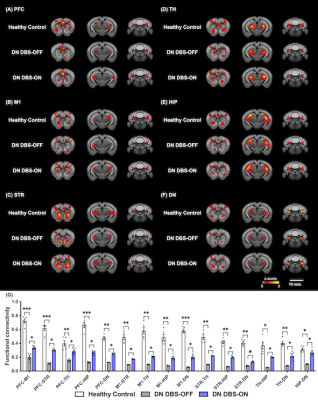 |
Screen Number: 19
0838. Restoring
Motor and Cognitive Functions with Dentate Nucleus DBS through
Enhancing Brain Functional Connectivity in PTI-Induced Stroke
Model
S-J Li, C-W Chang, Y-W Liang, T-C Chen, C-R Yang, Y-C Lo,
S-H Lin, Y-Y Chen
National Yang Ming Chiao Tung University, Taipei City, Taiwan
Impact: This study highlights DN DBS as a potential
therapeutic intervention for post-stroke rehabilitation,
bridging preclinical insights to clinical applications for
improved patient outcomes.
|
| 08:53 |
 |
Screen Number: 20
0839. CBV
mapping reveals regional brain activity changes in rats
following longitudinal focal Transcranial Magnetic Stimulation
(TMS)
C. Li, S. Hoffman, H. Nguyen, A. Vrana, A. Carney, Y. Duan,
Z. Ma, N. Zhang, Y. Yang, H. Lu
The Pennsylvania State University, University Park, United States
Impact: This is the first awake rat model that
replicates the focality and temporal patterns of TMS
conditions in humans, opening a novel platform further
investigating TMS-induced neuroplasticity.
|
| 08:55 |
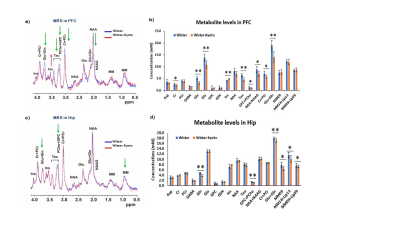 |
Screen Number: 21
0840. Accelerated
neuromodulation in treatment-resistant depression: preclinic
model characterization and treatment evaluation by multimodal
MRI
V. Zecca, M. Boffa, S. Spalletti, C. Cerri, M. Bertone, T.
Singh, G. Palombelli, M. Pettorruso, F. Zoratto, R. Canese
Istituto Superiore di Sanità, Rome, Italy
Impact: Our results show that increasing daily
stimulation frequency allows to shorten treatment duration
without compromising rTMS efficacy. The application of
accelerated neuromodulation in clinical settings would
improve patient compliance and cost-effectiveness.
|
| 08:57 |
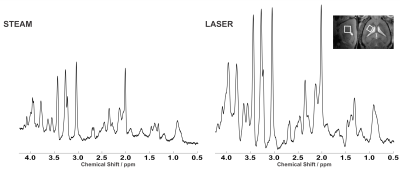 |
Screen Number: 22
0841. Preclinical
¹H MRS at Ultra-High Field: A Comparative Study of LASER and
STEAM Sequences in Mouse Brain
A. Abaei, D. K. Deelchand, F. Roselli, V. Rasche
Ulm University, Ulm, Germany
Impact: LASER's higher SNR can reduce scan time in
preclinical studies at UHF, enabling more efficient data
acquisition and facilitating advanced applications like
dynamic MRS and neurochemical profiling of smaller brain
structures.
|
| 08:59 |
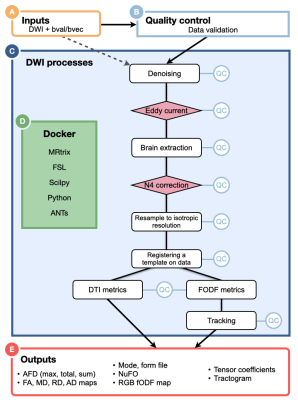 |
Screen Number: 23
0842. MouseFlow:
a pipeline for mouse brain diffusion MRI data, generating
tractograms and diffusion metrics with quality controls
E. Cosenza, A. Boré, A. Valcourt Caron, V. Ozenne, A.
Trotier, M. Descoteaux, S. Miraux, L. Petit
Groupe d’Imagerie Neurofonctionnelle – Institut des Maladies Neurodégénératives (GIN-IMN), UMR5293 CNRS, Université de Bordeaux, Bordeaux, France
Impact: MouseFlow enables researchers studying the
rodent brain to standardise diffusion MRI workflows,
improving reproducibility and comparability between studies.
It facilitates studying brain connectivity in healthy and
pathological conditions, advancing translational
neuroscience with more robust and reliable data.
|
| 09:01 |
 |
Screen Number: 24
0843. Sex
differences in functional connectivity and behavior in a mouse
model of alcohol abuse disorder: functional implication of
Nucleus Accumbens.
P. Ortiz-Teba, M. Sourty, M. Rame, L. Degiorgis, L. Harsan
ICube Laboratory, University of Strasbourg, CNRS, Strasbourg, France
Impact: Combining behavioral and functional connectivity
analyses, enabled the identification of connectome profiles
by sex and AUD subtype. Emphasizing the lateralized role of
the Nucleus Accumbens, nuanced by sex and AUD subtype. These
insights inform targeted sex- and phenotype-adapted AUD
interventions.
|
| 09:03 |
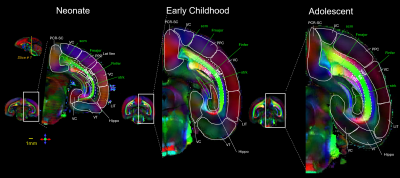 |
Screen Number: 25
0844. Common
coordinate frameworks of developmental marmoset brain from birth
to adolescence based on ultra-high-resolution diffusion MRI
T. Zhu, Z. Zhang, J. Guo, M. Ouyang, A. Sousa, J. Levine, A.
Kriegstein, H. Huang
Children's Hospital of Philadelphia, Philadelphia, United States
Impact: The first developmental marmoset brain CCFs from
birth to adolescence will allow integrating spatially
resolved and molecularly defined cell atlas with studies of
developing brain function, neurophysiology, and behavior.
They will provide insights into evolution and human-specific
features of brain development relevant to brain disorders.
|
The International Society for Magnetic Resonance in Medicine is accredited by the Accreditation Council for Continuing Medical Education to provide continuing medical education for physicians.